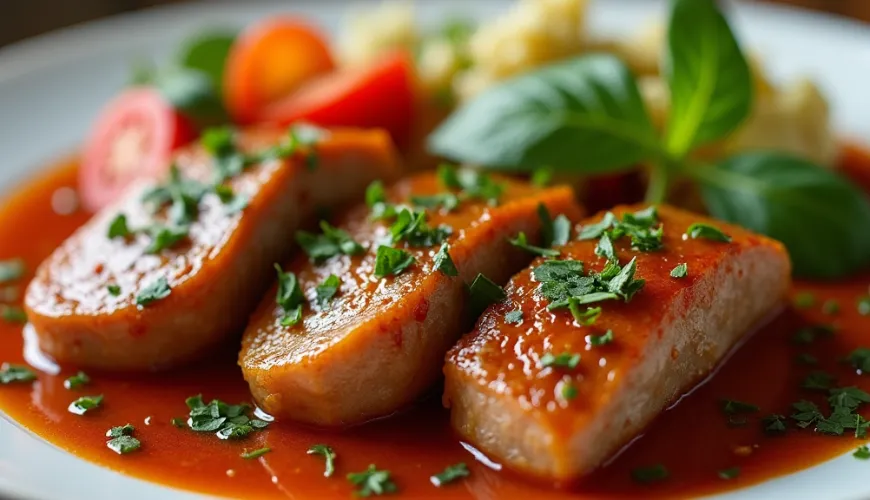
How to Prepare Delicious Tatar-Style Azu for Any Occasion

The Story of Tatar-Style Azu - A Traditional Dish That Found Its Way to Czech Tables
When you hear "Tatar-style azu," many people might think of an exotic dish from the far East, perhaps even from Central Asia or Siberia. In reality, it is a traditional dish rooted in Tatar cuisine, which developed in the region of present-day Russia. This hearty and aromatic dish, most often based on beef, has gained popularity in Czech households due to its richness and simplicity. Today, there are various variations—from the classic beef azu to less traditional versions with pork, appealing to a broader range of tastes.
Although the name might sound unfamiliar, the dish itself resembles something between a stew and braised meat with sauce. The word "azu" likely comes from a Tatar expression referring to meat cut into pieces, which perfectly describes the essence of the whole dish. The original recipe relies on simple ingredients—meat, onions, pickles, tomato paste, and garlic. Traditional seasoning with pepper and bay leaves is also included. In some variations, a potato side dish is added directly to the pot, making azu a complete main course without the need for additional sides.
Although it is a dish with a clear cultural background, its accessibility and heartiness have made it a staple not only in homes but also in restaurants offering rustic or Eastern European cuisine. The preparation is not complicated and can be handled by a beginner cook. More important than technique is the quality of the ingredients, especially the meat.
Classic Beef Tatar-Style Azu
Beef azu represents the most traditional version of this dish. Meat from the front part of the beef, ideally shank or neck, is used, as they have the right structure for long braising. The meat needs to be cut into strips, sautéed with onions, and then braised with pickles, tomato paste, and a bit of garlic. Pickles might initially seem unusual in a hot dish, but their acidity gives the sauce the right character. The resulting taste is balanced, slightly spicy, and warmly homely with every bite.
One of the advantages of Tatar-style azu is its variability. It can be easily adapted based on what you have at home. Don't have tomato paste on hand? You can use fresh tomatoes or tomato juice. Some even add pickled peppers or a bit of chili for a spicier version. In some parts of Russia, lamb is used instead of beef, but that's relatively unconventional.
A useful tip for lovers of more intense flavors: try marinating the meat first in a bit of oil, garlic, and ground pepper. This adds another layer of aroma that beautifully unfolds during braising. Azu is most commonly served with potatoes, but it also pairs nicely with rice or dark bread.
Pork Tatar-Style Azu
While the classic version with beef holds its place in history, pork azu is not as traditional. Nevertheless, it has gained a number of fans, especially in areas where pork is more available and popular. Pork shoulder or neck, when properly prepared, beautifully falls apart on the tongue and gives the dish a milder flavor that appeals even to those who aren't fans of strong beef.
In the kitchen of one Czech family, pork azu has become an annual winter dish. When it's freezing outside and one craves something hearty yet simple to prepare, this recipe comes in handy. A mother of three prepares a larger quantity, which lasts until the next day—and tastes even better because the flavors beautifully meld overnight. Such dishes often find their way into our culinary hearts. Not because of exoticism, but due to the simple, honest impression they leave.
How to Make Tatar-Style Azu Step by Step
Whether you embark on the classic beef or experimental pork variant, the basic procedure remains similar. Here's a straightforward list of steps to guide you through the cooking process:
- Prepare the meat: Cut it into thin strips and salt it.
- Sauté the onions until golden: In lard or vegetable oil, optionally with a piece of butter for a fuller taste.
- Add the meat and brown it on all sides.
- Pour in a bit of water or broth, add tomato paste, seasoning, and let it simmer covered.
- After about 45–60 minutes, add chopped pickles and garlic.
- Cook for another 15 minutes until the meat is tender and the sauce is the right thickness.
Cooking azu is not about speed but patience. The longer you braise the meat, the better the result will be. And if the sauce remains too thin, it’s no shame to add a teaspoon of flour mixed with water, or let some water evaporate without a lid.
From a nutritional standpoint, Tatar-style azu is a pleasantly balanced meal—it contains proteins from the meat, fiber from onions and pickles, and if you choose potatoes as a side dish, you'll also get complex carbohydrates. The pork variant has a slightly higher fat content, but this can be regulated by choosing a leaner cut of meat.
It's interesting that although Tatar-style azu originated in a completely different cultural context, its structure perfectly suits European dining preferences. Perhaps that's why so many people have come to love it here as well. Like goulash or pörkölt, it suits both a regular family lunch and a more festive occasion. And if the leftover portions aren't eaten right away, there's always the option to freeze them.
Regarding a more sustainable approach to eating—azu is a great example of how you can create a dish from available and basic ingredients that is tasty, hearty, and resource-friendly. You don't need to buy exotic ingredients or expensive meat—just a solid foundation and a bit of time. Moreover, it's a recipe that can easily be prepared in a vegetarian version with legumes or alternative proteins, making it a truly universal dish.
When we look at modern gastronomy today, we often hear about trends like "comfort food"—food that comforts us, warms us, and brings back memories. And that's exactly what Tatar-style azu is. A dish that connects flavors, traditions, and family dining.
As the famous French chef Paul Bocuse once said: "Recipes are not passed down precisely—they pass on the love of food." And azu is a beautiful example of this.

